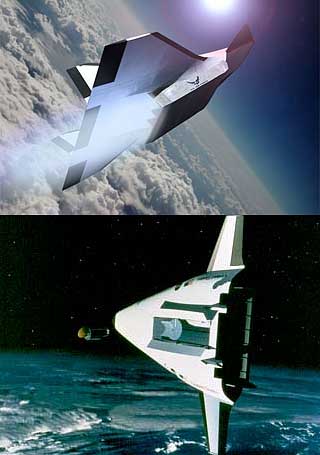Reusable Launch Vehicles
The idea of reusable launch vehicles is a recent
development in the space tourism industry. The U. S. space
program actually started in earnest with President John F.
Kennedy's pronouncement that the United States intended to
put an American on the moon. The first earthlings to land
on the moon were American astronauts in 1969.
 Reusable Launch Vehicles
Reusable Launch Vehicles |
|
Manned flights to outer space were very expensive back then
because a novel set of spacecraft and gear had to be fabricated
for each manned mission. That's when the idea of reusable
launch vehicles were conceived.
When the Space Shuttle was launched, it ushered in a new
era of reusable launch vehicles, although only partly because
the bay that houses the rocket propellants are deemed expendable.
While the crew bay of the Space Shuttle is reusable, it takes
at least two months to refit the shuttle for another mission.
Again this entails a lot of cost just to reuse the space vehicle
and thousands of man-hours to complete the refitting work.
With estimates made available by NASA, it was found that the
cost of refitting and using a new space vehicle are almost
even. To launch a shuttle costs roughly $20,000 per kilogram,
a figure much higher than when expendable launchers are used.
The brouhaha about the viability of reusable launch vehicles
stayed in limbo for quite some time, until the private sector
tried its hand in this technology. Then the Ansari X PRIZE
competition was unveiled, which was searching for companies
that can effectively launch a spacecraft capable of suborbital
manned flights and land back safely on Earth. To qualify for
the competition, a vehicle must be made available for two
flights and only a week apart. Small players in the industry
started work in earnest because of the $10 million dollars
prize that awaited the winner.
Among the few companies that answered the call was Scaled
Composites. Aircraft design personnel were actually in
the forefront of developing a reusable launch vehicles for
private use. The competition happened to be a blessing in
disguise since this would also serve as a preliminary test
of their space vehicle. Moreover, if everything is found satisfactory,
a hefty reward is likewise at hand. All systems go was raised
for SpaceShipOne, the concept space vehicle from Scaled Composites.
Eventually the venture proved to be very successful with SpaceShipOne
reaching outer space at a height of over 70 miles above the
earth with speed reaching over mach 2.
The idea of reusable launch vehicles was deemed successful
because records obtained from the company revealed that it
only needed $80,000 to launch SpaceShipOne. Then fate intervened.
Due to the success of SpaceShipOne, British businessman and
CEO of the Virgin Galactic,
Sir Richard Branson said he desired a new design of a spacecraft
based on SpaceShipOne that will be utilized for his space
tourism program.
Virgin Galactic is one of the companies that will open its
doors to private space travel and a reliable, reusable launch
vehicles just like the SpaceShipOne is high on its list of
priorities. Virgin Galactic and a couple of other companies
are scheduled to launch the first tourists into outer space
by the early part of 2009, if delays would not forestall this
timetable.
|

